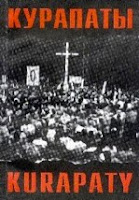
Kurapaty, Belarus: Site of Stalinist Purges, 1937-1941
Truth be told, I didn’t know the name of this place of mass murder until I did a little research. To me, the name of the place doesn’t matter too much.
The name, Kurapaty, however, does matter to those who were killed there, those who will never return from there, and the families they left behind.
I am not going to present you with a comprehensive nor historical look into the forests of Kurapaty here. I’ll just tell you how I came to know this place, what I saw when I was there, and what remains in my mind about the place ten + years out.
As you know, dear reader, I was in Belarus the summer between my third and last years at UPenn. After our month in the field, excavating a Bronze-age archaeological site near the village of Snydin in southern Belarus, we (me, Alyssa, and Emily; the three American girls) were wasting time in Minsk while our group’s American leader, Walt, “took care of business.”
One day we headed to Kurapaty by bus although I don’t know if I ever knew its name while in Belarus. It was a bit beyond the city, nestled into what seemed to be just another Belarussian village. Spare and empty. Rustic and idyllic.
We exited the bus, passed through the solemn town, and walked slowly into the sanctuary of the heavily wooded forest. Evergreen and sweet.
A middle-aged male Belarussian archaeologist who had been second in charge of the dig out in Snydin had apparently worked at this site.
Until recently, the people in the neighboring village and those in Belarus who had heard of Kurapaty most often thought (because they were told so by Soviet propaganda) that the site was one at which the Nazis executed locals and intellectuals during “the War,” World War II, that is.
Oleg had excavated here during the first thaw of glasnost and confirmed his suspicion that Kurapaty certainly was not a site of Nazi cruelty but one of an even-more malicious Soviet brutality.
Here beneath the swaying, murmuring pines the Soviets executed thousands of dissidents. The counts of victims range from 30,000 to 220,000 up to 250,000 people; men, women, and children.
I don’t recall hearing these figures or these details during this visit. I recall, however, spotting the bench presented by Clinton when he visited the forest the year before.
But, beyond all of this, I can still feel the serenity that ironically permeated the space, beneath the trees. It seemed so safe and elemental. It was this contrast between the natural beauty and the human cruelty enacted there that etched the woods in my mind.
I gazed heavenward and my body began to move side to side with the pines, languidly. Specks of blue sky and puffy white clouds flicked above, intertwined with the spindly fingers of the trees, reaching. This was the last view, the last thought, the last thing many of those executed here saw.
Comments